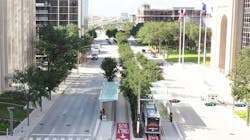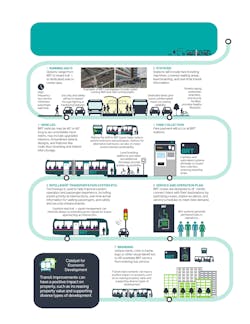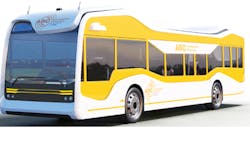One of the Best Transit Tools of the Future is an Old Friend - The Bus
During this time of rapidly emerging technologies and high automation deployed on the nation’s roadways, the transit world is making one of the most significant impacts to the future of mobility with an old friend – the bus. Over the course of its history, the bus has evolved to meet society’s needs as a safe, efficient and affordable mode of mass transport. Now, as the United States prioritizes transforming its mobility landscape, the bus is once again at the center of this paradigm shift in the form of bus rapid transit (BRT) service. BRT is the fastest growing mode of public transportation in the nation that transit agencies are leveraging to deliver high-capacity transit and meet ridership demands sooner and at a lower capital cost than rail transit. BRT projects also create opportunities for equity, accessibility and connectivity for transit-dependent commuters by offering premium transport service for all users. Through the planning, design and construction of a wide variety of premium BRT projects, the industry is shifting the mindset of urban transportation professionals to re-purpose the rights of way and measure success in the quality of experience over the expedient movement of vehicles.
AECOM is the general engineering consultant for the 25-mile University Line BRT project in Houston, Texas. It’s true what they say – everything is bigger in Texas – and this BRT project is no exception. The University Corridor traverses nearly all communities from southwest to northeast Houston and is slated to be the longest contiguous BRT system in the nation. Houston is fortunate to have a successful BRT Project in operation to help visualize other corridors but providing BRT the space to become the primary mode of throughput is still a new concept to many. Even with a catalog of case studies, detailed discussions are imperative to determine the best fit for each corridor.
The locally preferred mode that was determined from the AECOM-led study of the east-west high-capacity transit corridor in Columbus, Ohio, is also BRT. If completed as one corridor spanning approximately 22 miles, the east-west corridor would be categorized as a New Starts BRT project in the Federal Transit Administration’s (FTA) Capital Investment Grants (CIG) Program, similar to the University Line. To simplify the implementation in central Ohio, it was decided to implement the initial phase of the east-west transit study as two Small Starts BRT projects: West Broad BRT and East Main BRT.
What is BRT?
BRT is a high-frequency high-capacity high-reliability bus service that operates like rail transit. BRT can be implemented in existing city roadways as center-running, side-running, mixed-flow, or any combination thereof. A center-running BRT has bus lanes in a dedicated guideway in the center of the roadway. A side-running BRT, typically implemented as Business Access Transit (BAT) Lanes, runs in a dedicated bus lane along the outside curb. BRTs operating in mixed-flow are simply operating in general purpose lanes similar to a standard route. Transitions in guideway type are accommodated with queue jumps, where a transit phase in the traffic signal allows the bus to jump ahead of general-purpose traffic. In evaluating guideway options for a BRT corridor, project objectives need to be agreed upon early. The primary categories of the project undergo a technical evaluation process that includes a comprehensive range of criteria to shape the multi-modal character of a corridor.
Vehicle fleet selection, sizing the platforms for accessibility, transit signal prioritization, service integration planning and system branding are key elements that are integral in the development of a successful BRT system. A range of options for these elements are included in the alternatives screening process to ultimately arrive at a Locally Preferred Alternative (LPA) for the corridor in the project development phase for the FTA CIG program
Enhancing off-board mobility with BRT
BRT projects offer opportunities to enhance community connections for all modes of transportation and reach far beyond the transit elements. This is achieved in the planning phase with an approach that leverages BRT projects to improve community mobility. By leveraging BRT corridor investments to improve multi-modal mobility, stakeholders work together to accomplish common goals through improvements such as bike and pedestrian enhancements, micro-mobility and station area planning. This process includes analysis-driven decision-making data such as:
- Active transportation plans, including proposed bike and pedestrian enhancements and design standards that consider electric bikes/scooters and transit corridor street designations.
- Pedestrian crossing analysis to assess network safety and connection of the community activity centers through desire lines and alignment with adjacent land uses.
- Micro-mobility investments with bikeshare and allocated space for scooters.
- Mobility hubs for consolidated connections to local transit routes and/or micro-transit.
- Station area planning to really capture and improve the reach of BRT stations to the surrounding community through first and last-mile connections.
Using this data as a framework compiled in easily sharable maps and reports allows comparison of existing conditions and planned improvements. The connections that can be enhanced to improve overall connectivity and safety of the transportation network are more easily consumed by transit agencies and local community leaders in maps and diagrams. Because these projects often take more years to implement than the term limits of some decision-makers, these graphics also need to be archived carefully to offer similar results if re-analyzed in the future. This process used to develop elements included in the baseline project can also serve to identify future enhancements.
The future of BRT
BRT is rapidly becoming the mode of choice because it is flexible, scalable and can fit within the constraints of any urban or suburban environment. BRT has the flexibility to be implemented incrementally in different settings to meet community and operational needs. BRT projects are not without trade-offs; repurposing lanes for dedicated BRT guideways on congested city streets can prove to be a paradigm that challenges the logic of traffic engineers. However, cities are embracing initiatives such as Vision Zero, which leads to lane reductions and ultimately can convert single occupancy vehicles to a transit mode.
In the pursuit of premium BRT service for everyone, transit professionals seek to have as much dedicated guideway as possible in planning BRT corridors. Continuous, dedicated guideways pave the way for automated vehicles which, ultimately, will help relieve operator shortages that have forced the industry to reduce service. The Automated Bus Consortium is working with transit agencies to advance the deployment of automated buses across the U.S.
In the company’s collective BRT experience, the transit industry is finding that even metropolitan areas that have yet to see the ridership to make corridors ripe for BRT service can benefit from the basic principles behind BRT. It is imperative the nation prioritize buses in the urban environment to provide fast, frequent and equitable transit service to sustain growth.
Let’s embrace this old friend – the bus. The space allocated in public rights of way to BRT is one of the most critical components in the future for all mass transit systems.
-------------
Bill Crowley currently serves on the American Public Transportation Association BRT Design Committee
Fabiola Dagrin is a civil engineer with 20 years of experience in multi-disciplinary engineering and consulting projects, where she has helped both public and private sector clients plan, design and build complex infrastructure.

Bill Crowley | BRT Design Manager, AECOM
Bill Crowley strives to give transit a more prominent placement in the urban fabric through innovative approaches. He has a wealth of knowledge on effective designs that are now operational in Cleveland, Ohio, Salt Lake City, Utah, Grand Rapids, Mich., Provo, Utah and Omaha, Neb. He works diligently with his teams to develop realistic plans with appropriately allocated contingency. Crowley has over 20 years of transit experience ranging from Arterial bus rapid transit (BRT) to light-rail transit (LRT) on new alignments, all with utility, trail and facility design. He currently serves on the American Public Transportation Association (APTA) BRT Design Committee. His desire to follow an urban roadway design into construction led him to work on Cleveland’s HealthLine BRT from 2002 to 2007. Having grown up with a wheelchair-bound brother, he saw transit as the greatest way to equitably improve the quality of life for residents and workers in any community.

Fabiola Dagrin | Deputy Design Manager, AECOM
Fabiola Dagrin is a civil engineer with 20 years of experience in multi-disciplinary engineering and consulting projects where she has helped both public and private sector clients plan, design and build complex infrastructure. She brings a diverse background in conceptual engineering, preliminary engineering, final design and construction administration for highway, rail, aviation and civil site development projects. Her extensive experience includes design, design oversight, consultant management and stakeholder coordination. She served as a task lead for the completion of NEPA documentation for two new MetroRapid bus rapid transit's corridors, as part of CapMetro’s Project Connect program. Her experience has equipped her to approach projects in a holistic way, considering all facets of the built environment to achieve the best outcome for the greater good.





